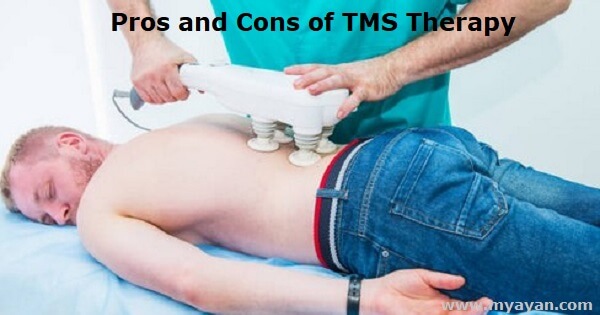It’s common to feel depressed at this age. The Anxiety & Depression Association of America states that depression affects over 40 million adults in the US every year. When a disease becomes so common, its treatment methods also evolve with advancements in technology. TMS or Transcranial Magnetic Stimulation is one of the best treatments for anxiety and depression. IT’s painless, non-intrusive, and quick. But, since it involves electrical equipment, it’s also wise to consider the downsides. Here are the potential Pros and Cons of TMS Therapy you need to know about.
TMS stands for Transcranial Magnetic Stimulation. It uses a strong magnetic field to target specific areas of the brain underactive in people with depression. The treatment is painless, easy, and fast.
Your doctor will only place a treatment coil on your head near the part of your brain where it needs help. You'll feel some tapping sensations as the machine sends pulses to this area. The treatment takes about an hour or so, once every weekday over 4-6 weeks on average.
TMS Therapy is a type of Neurostimulation that healthcare providers can prescribe to those who suffer from disabling depression. It uses magnetic fields to stimulate nerve cells in the brain. This stimulation can help with mood and memory problems and might even provide relief for those who have suffered strokes or other types of brain injury.
TMS therapy is a non-invasive treatment option. This means that it does not involve surgery and does not require the use of needles. There are a number of pros to TMS therapy to have.
TMS therapy is a non-invasive procedure that does not require the patient to be put under General Anesthesia. This is one of the significant Pros of TMS Therapy over other brain stimulation therapies such as Electroconvulsive Therapy (ECT) and Deep Brain Stimulation (DBS).
TMS therapy sessions usually last around 37 minutes, much shorter than the typical ECT or DBS treatment sessions. So, if you have fixed an appointment for the treatment, you won’t have to take a day off; you can resume your work right after the therapy.
TMS therapy has been found to have few side effects, which is another advantage over ECT and DBS. The most common side effects are mild headache and scalp discomfort.
TMS therapy can be used together with medications and other brain stimulation therapies, which is advantageous over DBS since it can only be used on its own.
TMS therapy is effective in managing a more comprehensive range of mental health conditions compared to ECT and DBS. This makes TMS therapy more widely applicable in treating mental health disorders.
There are a few potential but rare cons of TMS therapy. One is that it can be expensive if you don't have insurance coverage. Another is that not everyone responds well to TMS therapy. Some people find it doesn't help them. Finally, there's always a small risk of side effects like headaches or nausea.
Although TMS therapy has been found to have greater efficacy than most other neuromodulation treatments in managing the major depressive disorder, it may not work for all patients suffering from anxiety disorders. The numbers vary depending on which study you examine. Still, according to researchers, only about 20% of patients who receive TMS therapy for major depressive disorder achieve remission.
Since TMS therapy is administered every day over a period of 4 to 6 weeks through a course, it requires commitment from the patient and their family or caregiver. The inconvenience might be an issue for some people, especially for working professionals.
Some people may experience temporary side effects such as headache and scalp discomfort when beginning treatment which can be minor cons of TMS therapy. However, these tend to disappear within a couple of sessions. Patients are advised not to drive or operate heavy machinery during treatment as this could be dangerous.
TMS therapy stands out from other neuromodulation therapies because it is more expensive. DBS, for example, costs around $60 to $100 per visit. It’s still manageable, but considering the overall cost can be burdensome for many.
Although the price of TMS therapy may be justified by its efficacy in treating major depressive disorder, not all people can afford it due to a lack of health insurance coverage or limited health insurance benefits. This issue needs to be resolved if the treatment will ever become widely accessible.
Conclusion on the Pros and Cons of TMS Therapy
TMS therapy is often used to treat depression, obsessive-compulsive disorder (OCD), post-traumatic stress disorder (PTSD), and other mood disorders. It can also be used to treat many chronic pain conditions such as headaches or neuropathic pain. The treatment is quick, but you may take longer to appoint a meeting with the healthcare provider. Also, there are costs associated with the treatment. Therefore, consider the overall pros and cons of TMS Therapy to figure out whether it's the right way out or not.

1. Facial twitching during treatment.
2. Skin redness at the site of coil placement.
3. Fear of the procedure and during its implementation
4. Mild discomfort (usually dissipates by the end of first treatment).
5. Headache.
According to a 2011 study, repetitive transcranial magnetic stimulation (TMS) increased anxiety in individuals with panic disorder. However, there is no evidence that TMS makes most patients' anxiety worse.
The coil is placed on the outside of the patient's head to give small magnetic pulses during TMS treatment. It is non-invasive and does not require anesthesia. It also does not affect cognitive function or memory and does not cause a seizure.
TMS can help approximately 50% to 60% of those who have tried and failed to receive relief from medicines. Around one-third of these people experience a complete cure, which means their problems vanish entirely.